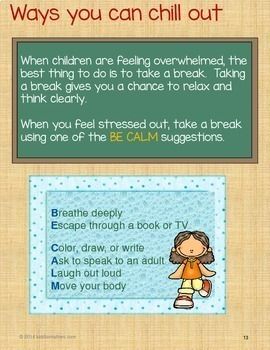3 Breaths Practice: ask your students to take three slow, deep breaths at regular intervals, before the new lesson starts or whenever you see anxiety or tension in your class. Provide students with calming breathing technique and add visual signals to prompt them to begin breathing.
This beneficial practice can also be adopted by staff members for stress relief and relaxation.
-
Stress-management for students (and teachers): activities to reduce stress (new ideas each week!)
-
Powerful Listening:
Make a sustained sound with a bell, wind chime, or any other object that creates a lingering sound.
Ask your students to listen attentively and raise their hands once they can no longer hear the sound.
Once everyone agrees that the sound has ceased, set a timer for one minute. Encourage the students to sit in silence during this time.When the tme is up, invite them to share their observations about what they heard during that quiet minute.
-
Body Scan
Invite your students to focus on their bodies. You can make this activity together with the group. Make sure you are feeling centered with both feet on the floor.
Then you can play this video and ask your students to follow the instrucions https://www.youtube.com/watch?v=xLoK5rOl8Qk
You can also guide your students yourself without the video.
Notice when and where you are feeling tension or when your breathing is shallow and practice Three Breaths exercise to help you feel more relaxed.
-
Mindful Reflection
Dedicate time at the end of each day or week for students to reflect on their experiences with mindfulness practices. Encourage them to share their insights, challenges, and observations, fostering a sense of community and mutual support.You can give your students supporting questions to activate their reflection process. Give them a question, allocate some time to think individually, then invite students to share.
Here are some questions that can be used:- Something I learned today (this week) …
- I am curious about…
- I am looking forward to tomorrow because…
- Something I’ll do (next, later today, this weekend, before the end of the week, etc.)…
- A question I still have is…
- I had the best feeling today when…
- Something from today that I am grateful for/thankful for/appreciative of is…
-
Nature Walks
Take students on nature walks around the school campus or nearby outdoor spaces. Encourage them to observe their surroundings mindfully, paying attention to the sights, sounds, and sensations of nature.
Afterward, facilitate a discussion about their observations and feelings. -
Guided Visualization
Lead students through guided visualization exercises where they imagine themselves in a peaceful and serene environment, such as a tranquil beach or lush forest. Encourage them to engage all their senses in the visualization to evoke feelings of relaxation and calm.
-
Mindfulness Art Projects
Provide opportunities for students to express their creativity through mindfulness art projects, such as mandala coloring, doodling, or mindful painting. These activities encourage self-expression, promote relaxation, and enhance focus and concentration.
-
Mindful Eating Exercises
Engage students in mindful eating exercises where they savor a small piece of food slowly and attentively, using all their senses to explore its texture, taste, and aroma.
This practice promotes mindful eating habits and encourages gratitude for nourishing food. -
 Hello everyone, there is already a great list of stress-management techniques.
Hello everyone, there is already a great list of stress-management techniques.Have you had a chance to participate in any of the activities yet?
Vote for the activity you would like to try.
It would be great to read your thoughts.
What do you think, should teachers organize these activities or is it not worth spending class time on them? -
Here are some stress-management activities for students and teachers:
-
Mindful Breathing Sessions: Incorporate short mindfulness exercises into the daily routine, focusing on deep breathing and being present in the moment.
-
Outdoor Walks: Organize weekly nature walks or outdoor activities to help students and teachers connect with nature and reduce stress levels.
-
Art Therapy: Set up regular art therapy sessions where students and teachers can express themselves creatively through painting, drawing, or other art forms.
-
Yoga Classes: Offer weekly yoga classes for students and teachers to practice relaxation techniques, improve flexibility, and reduce stress.
-
Journaling: Encourage daily journaling as a way for students and teachers to reflect on their emotions, experiences, and stressors.
-
Music Therapy: Host music therapy sessions where participants can listen to calming music, play instruments, or even learn how to create their own music.
-
Guided Imagery : Conduct guided imagery exercises where students and teachers can visualize peaceful and calming scenes to promote relaxation and reduce stress.
-
Laughter Yoga: Introduce laughter yoga sessions to promote laughter and joy, which can help alleviate stress and boost mood.
-
Healthy Cooking Workshops: Teach students and teachers how to prepare nutritious meals and snacks that can support their mental and physical well-being.
-
Group Discussions: Organize weekly group discussions where students and teachers can share their stressors, challenges, and coping strategies in a supportive environment.
-
Puzzle Breaks: Incorporate short puzzle breaks into the school day, such as solving crosswords, Sudoku, or riddles, to help students and teachers relax and refocus.
-
Gratitude Practice: Foster a culture of gratitude by encouraging students and teachers to express appreciation for the positive aspects of their lives through daily gratitude exercises.
-
Guided Relaxation: Lead guided relaxation sessions that focus on progressive muscle relaxation, body scans, or visualization techniques to promote deep relaxation and reduce stress.
-
Stress B***s and Fidget Toys: Provide stress b***s and fidget toys in classrooms to give students and teachers a physical outlet for stress and anxiety.
-
Pet Therapy: Arrange visits from therapy animals or create a pet-friendly space where students and teachers can interact with animals to reduce stress and promote well-being.
These activities can be rotated weekly to keep things fresh and engaging while providing consistent support for stress management


"Empowering students through engaging education, fostering environmental consciousness, and advancing scientific literacy. Committed to shaping future leaders in Life and Earth Sciences."
-
-
@Ana_moderator
Just want to share one of my method.
Introduce chapter / topic with a Challenge:
Before I TELL the students how to do something, I let them first try it themselves. This gets those creativity flowing and encourages them to think critically.
For instance, when I teach a lesson on trees classification, I ask students to write different trees name and, without much instruction, challenge them to group the trees in ways that they thought made sense, based on similarities. The students came up with some pretty interesting ways to group the trees and then we follow with the discussion on the concept of classifying.
(Note: This exercise does not exceed more than 5 to max 7 mins.)Have you tried any methods that might be interesting or innovative?? Do share with us.

-
@Ana_moderator
Love this idea! Imagination works! -
@Ana_moderator it's just great !!!! I will definitely use these techniques in my classroom . It sounds like so much helpful.
-
@ANWAR4678aa33b6 thank you for sharing! To me, it is a great example of active learning !
-
@Mariam said in Stress-management for students (and teachers): activities to reduce stress (new ideas each week!):
I will definitely use these techniques in my classroom . It sounds like so much helpful.
Please feel free to try any of theese instruments and share with us how it goes with your students! Super interested!
-
@Ana_moderator I think best way to manage stress in class is to have friendly relationship with students but in discipline.
What I do is to Identify the student's behaviour if it is unusual I talk to his or her peers first see his or social activities and go to counselling my students at least once in a week.
Secondly whatever my inner feelings or problems I I've I keep them a side and give healthy environment to my students.
Thirdly taking them outside the class asking for deep breaths and thinking to thank God to bless us healthy and complete body parts. Count the blessings and thank God every day .and so on give 5 to 10 minutes on alternating days . -
It is BrillianT having ideas on a weekly basis! Teachers are very good at managing stress today. What really disturbs them are administrative tasks. Research says that potential efficiency gains on administrative tasks can reduce teacher stress and risk of attrition.
-
@Bilim said in Stress-management for students (and teachers): activities to reduce stress (new ideas each week!):
It is BrillianT having ideas on a weekly basis!
Yes, I have temporarily stopped posting new activities each week, as there has already been a lot of information about stress management techniques. And I wanted to give you (the forum members) a chance to provide feedback and share your own ideas.
-
Mandalas are very useful for my students. I try to make a balance in the use of technology and functional strategies with no tech. Here you can see one of my students right after a tantrum. She loves to color mandalas to recover calm.
No matter what they know stress and anxiety is part of being humans, those feelings move us.
Best,
Mr. Bryan
